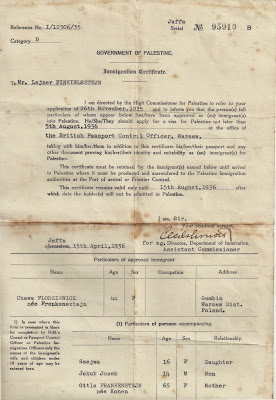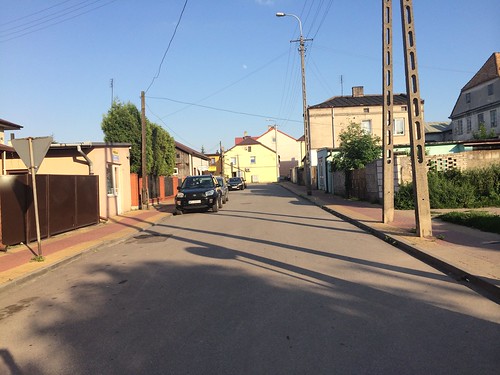Here’s a tale of three brothers, all born in Gombin (‘Gabin’ in Polish) around 1780-1800. Or maybe four.
Lewek - my great-great-great-grandfather - stayed in Gombin, Moszek moved to Plock around 1810, and Wolf moved to London around 1820. In a declaration in 1840, Lewek says that “the family here (in Poland) chose the name FRANKENSZTEJN, but my brother in London chose WAJNBERG”.
This generation straddles the period when Jews in Poland were first obliged to take surnames, in 1822; each household was supposed to choose a different surname, so that the authorities could tell which was which. Previously the Jewish tradition had been to identify a person by the name of their father - their ‘patronymic’ name. So all three brothers are identified in the earlier records as ‘Jakobowicz’ - son of Jakob.
The records I have found show a clear progression in this family towards the adoption of a surname, as can be seen in the records I have found for Moszek. In 1812 he is Mosiek JAKUBOWICZ (patronymic) from Gombin, in 1818 he is Mosiek Jakob GABINSKI (place of origin = Gombin), and from 1824 onwards he is Mosiek FRANKENSZTEJN. In the 1818 record the name ‘Jakob’ could be interpreted as a second given name - ‘Mosiek Jakob’ - but I think this is unlikely, because children were not named after their fathers, but after a recently deceased close relative, such as a grandfather or great-grandfather. I think this 'Jakob' is not a given name, but a patronymic, without the patronymic ending - 'Mosiek son of Jakob'; none of the later later records refer to him by the given name ‘Jakob’.
So much for the three brothers. But could there be a fourth? In the Plock records throughout the 19th Century there are only two identifiable FRANKENSZTEJN families, and no other individuals using the name. One is the family of Moszek, the other is of a man called Szmul. They are the only FRANKENSZTEJNs in town. Could they be brothers?
The earliest records I have found which I can identify as being for this Szmul are from 1817 and 1819, where he is simply Szmul IZRAEL. Unfortunately none of his records seem to identify his father directly. Is ‘Izrael’ being used in these early records as a second given name, or as a patronymic, as I think is the case of ‘Mosiek Jakob'? If it is a patronymic, his father is Izrael and he is not a brother to Moszek (whose father was Jakob, of course) and we are looking at two men, who are not siblings, nevertheless choosing the same surname.
A further twist is that in the late 1810s they seem to have been living in adjacent houses: Moszek at Nowa 65, and Szmul at Nowa 64. Intriguingly, two generations later, a grandson of Moszek and a grand-daughter of Szmul are each raising families in the same house, at Bielska 17.
The couple Sura and Szmul Hersz KLAJNFELD, by the way, are cousins - their mothers are sisters, Golda and Hana, daughters of Szmul FRANKENSZTEJN. And this Moszek is the son of Icek Jankiel, son of the original Mosiek JAKUBOWICZ later FRANKENSZTEJN. Who said this was going to be straightforward?
Now Moszek and Szmul could just have been very close neighbours, so close they chose - and were allowed to keep - the same surname. Or they could be brothers. If they are brothers, I get a whole stack of new cousins.
Is that just wishful thinking?











